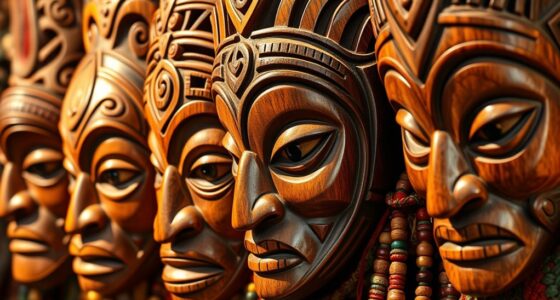Cinema deeply influences Indian visual arts, transforming aesthetics and cultural narratives. You'll notice how Bollywood's vibrant colors and dramatic themes find their way into contemporary artworks, reflecting societal trends and aspirations. Iconic artists like Raja Ravi Varma established a foundation that blends Western techniques with Indian themes, shaping early cinema's storytelling. The growth of independent films further diversifies this artistic landscape, bringing regional narratives to the forefront. While critiques of consumerism and oversimplified storytelling remain, the fusion of traditional art with modern film continues to redefine cultural identity. There's much more to explore about this fascinating interplay.
Key Takeaways
- Bollywood influences contemporary Indian art through vibrant color palettes and dramatic narratives that reflect cinematic aesthetics.
- Early Indian cinema, inspired by Raja Ravi Varma, shaped character portrayals and set designs in visual arts.
- Hand-painted cinema hoardings showcase craftsmanship, reflecting societal trends and enhancing the connection between art and popular culture.
- The integration of traditional art forms with modern storytelling redefines cultural identity and expression in Indian visual arts.
- Cinematic visual storytelling has evolved through collaborations between filmmakers and artists, enriching the narrative depth in Indian art.
Bollywoodization Explained
Bollywoodization, at its core, is the phenomenon where elements of Bollywood cinema—like its catchy music, vibrant dance routines, and engaging narrative styles—are woven into various media platforms, including television and advertising. This trend shapes popular Indian visual culture by creating a unified narrative that blends regional traditions with contemporary themes.
You may notice how urban lifestyles and wealth are often glamorized, which influences societal values and aspirations. The incorporation of Bollywood elements can also be seen as a reflection of self-awareness and emotional intelligence in communication, as these themes resonate widely with audiences exploring diverse dating platforms.
As Bollywoodization permeates your everyday life, it alters perceptions of beauty and success. You might find yourself drawn to Bollywood fashion trends, adopting styles that reflect the glamour portrayed in films. This shift not only impacts individual choices but also drives significant economic growth, as the Bollywood industry generates substantial revenue and attracts foreign investments. It contributes to sectors like tourism and merchandise, creating a vibrant ecosystem.
However, it's crucial to recognize the criticisms surrounding Bollywoodization. Detractors argue it oversimplifies complex cultural narratives and promotes consumerism, often sidelining regional filmmakers who advocate for local stories.
As you engage with this phenomenon, consider both its allure and the implications it has on the diverse tapestry of Indian visual arts.
Cultural Impact on Visual Arts

The influence of Indian cinema, especially Bollywood, extends well beyond the silver screen, leaving a lasting mark on visual arts across the country. Bollywood films popularize specific aesthetics, themes, and styles that you see reflected in contemporary Indian art. Many artists today adopt the vibrant color palettes and dramatic narratives reminiscent of cinematic glamor, creating works that resonate with viewers familiar with film imagery.
This intersection of art and film can be seen as a reflection of astrological compatibility affects romantic attraction, where the blending of narratives creates deeper emotional connections. Raja Ravi Varma's fusion of Western techniques with Indian themes laid the groundwork for early Indian cinema, impacting set designs and character portrayals in films. This crossover influences how artists conceptualize their work, incorporating cinematic elements to communicate cultural stories.
Moreover, the rise of hand-painted cinema hoardings showcases unique craftsmanship while promoting Bollywood films, serving as a visual barometer for societal trends. As cinema continues to evolve, there's a growing opportunity for artists to weave traditional art forms into contemporary narratives.
This integration redefines cultural identity, enriching the visual arts landscape and highlighting the enduring relationship between Indian art and Bollywood films. By embracing these influences, you can witness the powerful dialogue between cinema and visual arts.
Economic Influence of Cinema

Cinema plays an important role in shaping the economic landscape of India, with the Bollywood film industry generating over $2 billion annually. This remarkable revenue not only boosts the economy but also sparks the Bollywoodization of popular Indian culture, influencing everything from fashion to lifestyle choices.
Additionally, the growth of digital platforms enables greater accessibility to Bollywood content, allowing audiences worldwide to engage and invest in this vibrant industry, showcasing best websites for online earning that leverage cinematic trends.
Increased investment in Bollywood productions has led to growth in sectors like tourism and merchandise, creating jobs and stimulating local economies. As digital platforms rise, offering Bollywood content worldwide, the market reach expands, attracting foreign investments and collaborations that further enhance the economic influence of cinema.
Moreover, Bollywood's global appeal fosters international partnerships and co-productions, presenting new opportunities for local filmmakers and artists to thrive.
However, this economic boom often juxtaposes the glamour of Bollywood with the stark reality of rural poverty. This contrast prompts critical discussions on wealth distribution and the socio-economic implications of cinematic portrayals.
As you engage with cinema, it's important to recognize its profound economic impact, not just in entertainment but in shaping various facets of life in India. The relationship between cinema and economy is complex, yet undeniably influential.
Critiques of Bollywood Culture

Many critics argue that Bollywood culture oversimplifies narratives, risking the rich diversity of India's regional traditions. This homogenization can dilute the authenticity and depth found in local storytelling, ultimately shaping a narrow view of Indian culture.
Furthermore, the portrayal of gender roles in Bollywood films has faced scrutiny for reinforcing stereotypes. You'll often see women confined to limited roles that prioritize traditional values, sidelining modern representations that reflect today's society. This issue mirrors broader societal discussions, such as the role of quorum sensing in bacteria, which emphasizes communication and collective behavior that can be stifled by dominant narratives.
Critics highlight three primary concerns:
- Materialism: Bollywood's glamor often promotes consumerism, influencing perceptions of success and beauty, especially among youth.
- Stereotypes: The repetitive depiction of gender roles limits the narrative scope, failing to showcase a fuller representation of women's experiences.
- Resistance: Regional filmmakers push back against mainstream narratives, advocating for a richer tapestry of local stories that reflect diverse visual cultures.
As Bollywood faces a decline in foreign revenue, dropping from 30-40% to 20-25%, the future relevance of this cinematic form is under scrutiny.
This decline raises critical questions about how diverse artistic expressions will fare amidst the pressures of commercialism in the Bollywood film industry.
Future Trends in Cinema

As independent cinema continues to rise, you'll notice a shift towards more authentic regional storytelling in Indian films.
This trend not only gives voice to diverse narratives but also challenges the mainstream's dominance.
Expect a richer cinematic experience as filmmakers embrace local cultures and unique perspectives, much like how emerging motivational speakers for 2024 bring innovative ideas to the forefront.
The growing emphasis on mental health and well-being in cinema will further enrich these narratives, offering audiences a deeper connection to the stories being told.
Independent Cinema Rise
Independent cinema in India is experiencing a remarkable rise, capturing the imagination of audiences who crave stories beyond the mainstream Bollywood narratives. This shift not only broadens the cinematic landscape but also enriches the visual culture of the nation.
Fostering social connections through cinema can help combat loneliness and create a sense of community among viewers. Here are three key factors driving this movement:
- Diverse Storytelling: Independent filmmakers challenge conventional narratives, showcasing underrepresented stories that resonate deeply with viewers. Films like *The Lunchbox* and *Gift of a Blind Horse* exemplify this growing appetite for alternative cinema.
- Digital Distribution: With the emergence of digital platforms, independent films can reach larger audiences without the limitations of traditional theatrical releases. This accessibility allows for a more vibrant and varied cinematic experience.
- Cultural Experimentation: The fusion of traditional art forms with contemporary storytelling techniques in independent cinema reflects a broader trend of innovation in Indian visual arts. This experimentation encourages new expressions and invites audiences to engage with diverse narratives.
As global viewers seek varied stories, independent cinema is poised to greatly influence India's cinematic landscape and cultural discourse in the years ahead.
Embrace this evolution, as it shapes the future of storytelling in India.
Regional Storytelling Diversification
Across India, regional storytelling is rapidly gaining momentum, reshaping the cinematic landscape with fresh narratives and authentic voices. This shift is rooted in the rise of independent cinema, which challenges mainstream Bollywood narratives and showcases diverse cultural experiences. Digital platforms have become a game-changer, allowing filmmakers to reach wider audiences and reflect local traditions and issues.
The increased global demand for varied narratives encourages greater representation of regional languages and cultures in Indian film, inviting filmmakers to explore their unique storytelling styles. Collaborative projects between independent filmmakers and traditional artists emerge, blending regional storytelling with contemporary cinematic techniques.
| Aspect | Impact on Indian Film | Influence on Visual Culture |
|---|---|---|
| Independent Cinema | Challenges mainstream narratives | Introduces diverse perspectives |
| Digital Platforms | Expands audience reach | Fosters inclusivity in storytelling |
| Collaborative Projects | Merges traditional and modern styles | Enriches visual storytelling |
This diversification is set to reshape Indian cinema, promoting cultural authenticity and deepening your understanding of India's multifaceted identity. Embracing these regional stories enriches the visual culture, connecting you to the heart of local traditions.
Raja Ravi Varma's Legacy

Raja Ravi Varma's innovative techniques transformed how you see Indian art, merging Western styles with rich cultural themes.
His ability to capture the essence of emotions and narratives can be likened to the way artistic journeys explore cultural resonance.
His impact on early cinema is undeniable, as filmmakers drew directly from his vivid portrayals of deities and women.
Artistic Innovations and Techniques
Revolutionizing the portrayal of deities and historical figures, Raja Ravi Varma blended Western artistic techniques with Indian themes to create a distinctive style that captivated diverse audiences.
His innovative approach not only transformed traditional art but also laid the foundation for modern visual culture in India. The use of natural materials and a focus on authentic representation, much like the essentials for a farmhouse bathroom, reflect Varma's commitment to integrating cultural elements into his work.
Here are three key innovations that define Varma's legacy:
- Mass Production: His lithographs made high-quality art accessible, fostering a new appreciation for art traditions among the general public.
- Light and Shadow: Varma's mastery of chiaroscuro added depth and drama to his work, enhancing emotional connections and influencing early cinematic storytelling.
- Elegant Depictions of Women: His portrayal of women, marked by graceful elegance and vibrant colors, shaped how female characters were visualized in cinema, reflecting a strong narrative connection.
Varma's techniques and themes continue to inspire contemporary artists, highlighting a seamless fusion of traditional and modern styles in Indian visual culture.
His ability to merge diverse influences not only enriched art traditions but also paved the way for future innovations in both visual arts and cinema.
Cinematic Inspirations and Influence
Drawing from the rich tapestry of Indian mythology, the cinema of India owes much of its visual storytelling to the artistic innovations of Raja Ravi Varma. His unique blending of Western techniques with traditional themes revolutionized the depiction of deities, leaving an indelible mark on early Indian cinema. Dadasaheb Phalke, the father of Indian cinema, drew heavily from Varma's lithographs, replicating his vibrant scenes in mythological films and establishing a visual grammar that resonates today.
Varma's lifelike portrayals and masterful use of light and shadow created emotional connections that laid the groundwork for early cinematography techniques. His artworks popularized Indian mythology on screen, inspiring filmmakers to adapt characters from his paintings into cinematic narratives. Even today, exhibitions like "Bollywood Superstars" celebrate Varma's legacy in the context of Indian visual arts.
| Influence | Impact on Cinema |
|---|---|
| Lifelike depictions | Emotional connections in storytelling |
| Use of light and shadow | Foundation for early cinematography techniques |
| Mythological characters | Adaptation into film narratives |
| Blending Western and Indian art | Aesthetic evolution in Indian cinema |
Cultural Identity and Heritage
At the intersection of colonial challenges and a burgeoning national identity, Raja Ravi Varma's legacy profoundly shaped the cultural landscape of India. He revolutionized Indian art by merging Western techniques with traditional themes, which not only enriched the visual narrative but also fostered a sense of pride in cultural identity. His vibrant depictions of mythological figures became iconic, resonating with the masses during a time of struggle.
Varma's work parallels the emotional depth found in classic animated films, like *The Lion King*, showcasing the timeless themes of growth and responsibility.
Varma's influence permeated various aspects of Indian culture, particularly:
- Accessibility: His mass-produced lithographs democratized art, making it accessible to the broader public.
- Inspiration for Cinema: Dadasaheb Phalke drew heavily from Varma's work, infusing early cinema in India with his aesthetic and visual storytelling.
- Contemporary Resonance: Modern artists continue to reference Varma's techniques, creating a dialogue between traditional and contemporary identities.
Celebrated exhibitions, like the one at Louvre Abu Dhabi, underline Varma's enduring impact on both art and cinema.
His legacy reminds us of the interconnectedness of cultural heritage and the evolution of visual narratives, enriching our understanding of Indian identity in the cinematic domain.
Historical Development of Indian Cinema

The historical development of Indian cinema, rooted in the early 20th century, showcases a dynamic interplay between tradition and modernity. Beginning with Dadasaheb Phalke's mythological films from 1912 to 1934, Indian film laid the groundwork for popular visual culture in India. Phalke's work reflects traditional Indian art styles, particularly through its iconic frontality, emphasizing the connection between viewers and divine representations. This connection markedly enhances audience engagement, as it mirrors the exploration of philosophical literature in its ability to provoke thought and reflection.
The 1930s marked a pivotal moment with the introduction of the singing and musical genre, which became integral to Bollywood's evolution and cultural impact. Early Indian films, often inspired by British cinema and Hindu mythology, shifted into a variety of genres, broadening the cinematic landscape. You can see how this change not only diversified the film experience but also enriched the narrative forms.
As you investigate deeper into Indian cinema, the concept of darshan, or divine gaze, emerges as an essential element. It highlights the viewer's relationship with the screen, a theme that continues to resonate within Bollywood's dominant narrative.
This historical journey illustrates how Indian cinema has shaped visual arts and cultural expressions throughout the years.
Challenges to Bollywood Hegemony

Bollywood's dominance in the Indian film industry is increasingly being challenged by independent filmmakers who bring fresh perspectives to the screen. These creators focus on subaltern narratives and regional experiences, promoting authentic storytelling that resonates with diverse audiences.
Here are three key factors driving this shift:
- Digital Platforms: The rise of streaming services has opened doors for independent films, allowing them to reach a broader audience beyond the mainstream Bollywood framework.
- Cultural Critique: Many independent filmmakers critique Bollywood's tendency to perpetuate stereotypes and oversimplify complex cultural narratives, which has sparked a demand for more nuanced representations.
- Declining Market Share: As Bollywood's global market share drops from 30-40% to 20-25%, viewers increasingly seek varied cinematic expressions that reflect contemporary Indian society.
This movement not only poses challenges to Bollywood hegemony but also emphasizes the importance of recognizing and preserving India's rich visual culture.
Globalization's Effect on Cinema

How has globalization transformed the landscape of Indian cinema? It's reshaped how stories are told, blending traditional techniques with modern Western narratives. You'll notice a fusion of styles that create a more global cinematic language, making films more visually appealing to diverse audiences.
The rise of digital platforms has expanded Bollywood's reach, attracting viewers worldwide and fostering international collaborations.
However, as Bollywood's appeal grows, regional cinemas are stepping up, showcasing local narratives and aesthetics to meet changing audience preferences. With global markets contributing only 6.7% to Bollywood revenues, according to the FICCI-KPMG Report, adaptation is vital.
Filmmakers now prioritize representation and diversity, exploring varied themes and characters to engage a broader audience.
This shift not only enhances the global reach of Indian cinema but also enriches its visual storytelling, reflecting a myriad of cultural dynamics. By embracing these changes, Indian filmmakers can create works that resonate on both local and international stages, ensuring their stories remain relevant in an ever-evolving cinematic landscape.
Globalization is therefore a catalyst, driving innovation and diversity in the heart of Indian cinema.
Frequently Asked Questions
What Are the Impacts of Cinema on Indian Society?
Cinema shapes your perceptions of beauty, success, and gender roles in India. It influences fashion trends and cultural narratives, while also generating economic impact, often overshadowing regional stories and reinforcing stereotypes in society.
Why Is Indian Cinema Important?
Indian cinema's essential because it entertains, educates, and inspires. You experience diverse stories that reflect society, promote cultural understanding, and spark conversations, making it a crucial part of your life and community.
How Indian Culture Is Reflected in Indian Cinema?
You see Indian culture reflected in cinema through vibrant storytelling, traditional themes, and diverse narratives. Films showcase societal values, gender roles, and rich artistic expressions, making them a mirror of the nation's heritage and identity.
What Is the Role of VFX in Indian Cinema?
Imagine a world where your imagination comes alive—VFX in Indian cinema does just that. It transforms storytelling, captivates audiences, and elevates films like *Baahubali*, making them visually stunning and unforgettable experiences for you.
Conclusion
So, next time you're admiring a beautiful painting, just remember it's probably got a dash of Bollywood magic in it. Who knew that melodrama and dance numbers could inspire such creativity? As you sip your chai, ponder how our beloved cinema shapes everything from brush strokes to blockbuster budgets. Let's just hope the next masterpiece doesn't come with a dance-off. After all, the world could use a little less "item number" and a bit more "artistic integrity," right?









